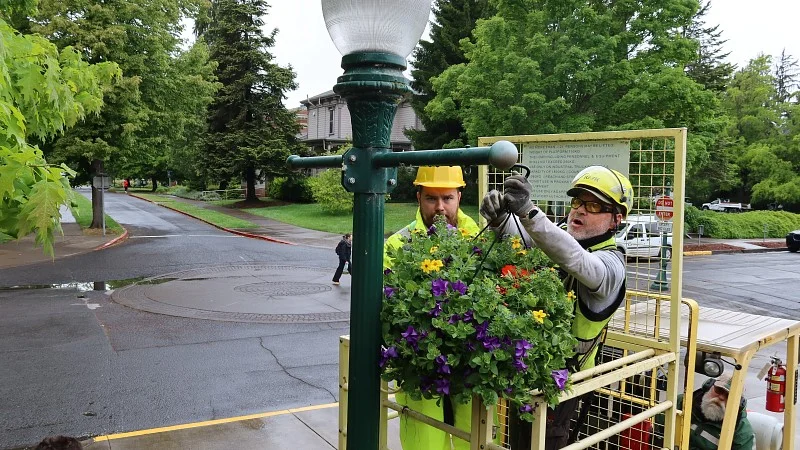With the planting of more than 9,000 flowers in a single day, the University of Oregon celebrated University Day 2025 by transforming its campus into a vibrant garden bursting with life and color. From massive hanging flower baskets to hand-planted blooms in planters across the grounds, the day was a celebration of plants, beauty, and community.
At the heart of it all was Lauren Meyer of Campus Planning and Facilities Management. Taking charge of this year’s floral design and execution, Meyer worked closely with landscape architect Jane Brubaker and a team of spirited groundskeepers to orchestrate the breathtaking botanical makeover. Her schedule began before sunrise, ensuring flowers were delivered, arranged, and ready for hundreds of eager volunteers.
“University Day feels like a lot of work, but we always get so many comments on the flowers,” Meyer said. “It really brings a lot of joy to people.”
Hanging baskets, each weighing nearly 100 pounds and soaked with water, were hoisted high above 13th Avenue. UO arborist Becket DeChant and custodian Andrew Sechrist deftly secured them into place from a cherry picker, perched above curious passersby. Thanks to time-saving carabiners, the intricate process of suspending the massive arrangements went more smoothly than in years past.
Despite the complexity of it all, DeChant, who’s worked this event for eight years, believes it’s worth every effort. “This strip really looks great. People notice. It’s important,” he said.
Meyer’s day began at 4 a.m., delivering trays of golden bidens and strawberry-hued marigolds to key planting areas at 13th and Agate Street. Volunteers arrived by 9 a.m., planting colorful blooms according to a detailed — albeit humorously debated — flower layout map. Despite the playful ribbing from her team, the planting operation moved with precision and camaraderie.
Grounds worker Harrison Freeland was among the early risers. “I was there at 6 a.m. — and I gave Lauren a hard time about her map, of course,” he laughed.
Beyond the aesthetics, many participants found unexpected peace in the act of gardening. Therapist Jill Siegfried of University Health Services explained that planting flowers and pulling weeds can actually trigger a dopamine release, helping people feel more grounded and accomplished. “Every time we see that flower we’re getting paid in feel-good hormones,” she said.
Other employees, such as Anika De, Katie Murray, and Daisy Wu of Finance and Administration Shared Services, appreciated the break from their desks and the chance to reconnect with coworkers across campus. As they planted China asters in front of Gerlinger Hall, they shared smiles and stories — a reminder that flowers can foster not only beauty, but also connection.
As tradition dictates, the day included a ceremonial tree planting. President Karl Scholz, joined by Angela Lauer Chong, vice president for student life, and Mike Harwood of Campus Planning, planted a young Oregon white oak in the Millrace Natural Area. “University Day is a powerful reminder of our shared responsibility to care for and sustain the natural spaces that shape our campus community,” Chong said.
Nearby, design associate Brianna Liberty took a hands-on approach, wielding a shovel against stubborn blackberry bushes. She was one of nearly 100 volunteers at the millrace who worked to remove invasive species, spread mulch, and restore native plant habitats. “I kind of enjoy manual labor,” Liberty said. “And in design, aesthetics matter — our surroundings influence the way we feel.”
By day’s end, natural areas steward Emily Hamblen surveyed the cleaned-up trails and native greenery with pride. “It’s the enthusiasm and the amount of people that were interested in making a difference,” she said. “It just blew me away.”
From a tangle of blackberry thorns to orderly rows of marigolds and petunias, University Day became a garden of transformation — powered by people, passion, and above all, plants.


